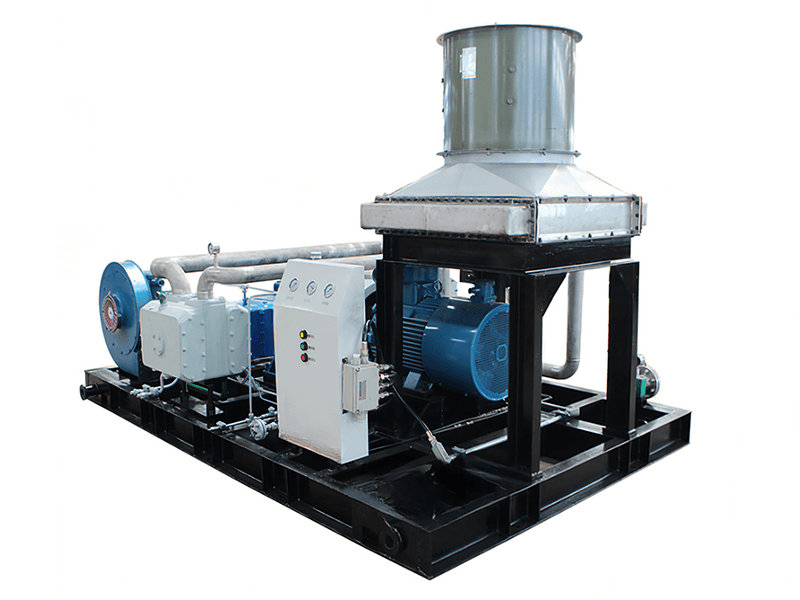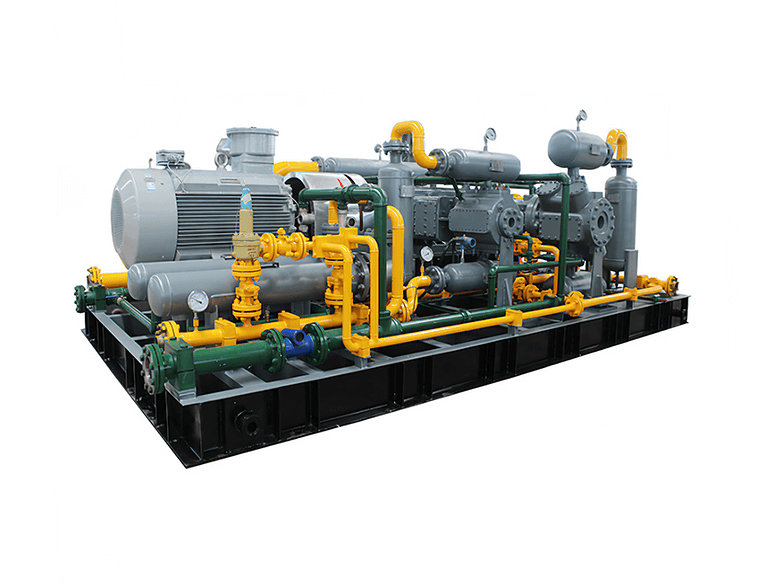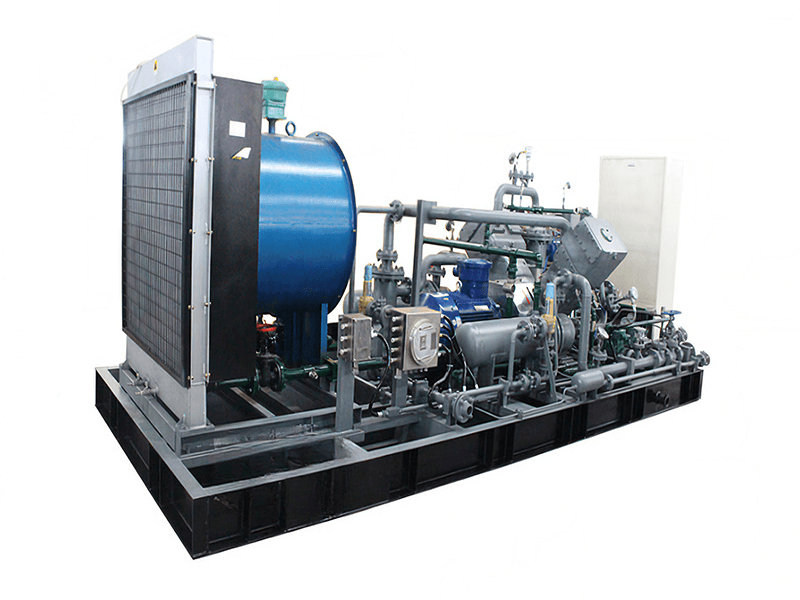Compressors used for natural gas recovery are specialized equipment designed to extract and compress natural gas from wells, reservoirs, or other sources. These compressors play a crucial role in the upstream production process by increasing the pressure of the extracted gas for transportation and processing. Here are some common types of compressors used for natural gas recovery:
1. Reciprocating Compressors: Reciprocating compressors, also known as piston compressors, are widely used in natural gas recovery operations. They use a reciprocating piston mechanism driven by an electric motor or an internal combustion engine. Reciprocating compressors are known for their high efficiency, wide pressure range, and ability to handle varying gas flow rates. They are often used in gas gathering systems, wellhead compression, and gas processing facilities.
2. Screw Compressors: Screw compressors, specifically oil-flooded rotary screw compressors, are commonly employed in natural gas recovery applications. These compressors use two interlocking helical rotors to compress the gas. Screw compressors are known for their smooth operation, high reliability, and ability to handle large gas volumes. They are often used in midstream and downstream gas processing, gas storage facilities, and liquefied natural gas (LNG) plants.
3. Centrifugal Compressors: Centrifugal compressors are used for high-pressure and high-volume natural gas recovery. They utilize centrifugal force to accelerate and compress the gas. Centrifugal compressors are known for their compact design, high flow capacity, and suitability for large-scale operations. They are often used in gas transmission pipelines, gas storage facilities, and LNG plants.

4. Rotary Vane Compressors: Rotary vane compressors are occasionally used in smaller-scale natural gas recovery operations. These compressors use rotating vanes within a cylindrical chamber to compress the gas. Rotary vane compressors are known for their simplicity, compactness, and relatively low cost. They are often used in small gas gathering systems, wellhead compression, and low-pressure gas recovery applications.
5. Axial Compressors: Axial compressors are primarily used in large-scale natural gas recovery operations, such as gas processing plants and LNG facilities. These compressors use a series of rotating blades and stationary stator vanes to compress the gas. Axial compressors are known for their high flow capacity, efficiency, and suitability for high-pressure applications. They are often used in gas transmission pipelines, gas liquefaction processes, and other large-volume gas compression operations.
6. Liquid Ring Compressors: Liquid ring compressors are used in natural gas recovery applications where the gas contains significant amounts of liquid or condensate. These compressors use a rotating liquid ring to create compression. The liquid ring acts as a seal and helps remove liquid from the gas stream. Liquid ring compressors are known for their ability to handle wet or dirty gases, resistance to liquid carryover, and tolerance for liquid slugs. They are often used in gas gathering systems, vapor recovery units, and applications involving gas with high liquid content.
7. Scroll Compressors: Scroll compressors are used in smaller-scale natural gas recovery operations, such as wellhead compression and small gas gathering systems. These compressors use two interleaved spiral scrolls to compress the gas. Scroll compressors are known for their compact size, quiet operation, and low maintenance requirements. They are often used in applications where space is limited, and a smaller flow capacity is sufficient.
8. Diaphragm Compressors: Diaphragm compressors are used in natural gas recovery applications requiring high gas purity or handling corrosive gases. These compressors use a flexible diaphragm to compress the gas. The diaphragm separates the gas from the moving parts, ensuring oil-free and leak-free compression. Diaphragm compressors are known for their gas purity, containment of leakage, and ability to handle various gases and mixtures. They are often used in gas chromatography, laboratory gas systems, and applications requiring precise control and gas separation.
9. Liquid Piston Compressors: Liquid piston compressors, also known as hydraulic piston compressors, are used in specific natural gas recovery applications. These compressors use a liquid piston, typically water or oil, to compress the gas. Liquid piston compressors are known for their simplicity, reliability, and ability to handle high-pressure gas. They are often used in applications where the gas requires contamination-free compression or when gas purity is a critical factor.
10. Jet Compressors: Jet compressors, also referred to as ejectors, are used in natural gas recovery processes where there is a motive fluid available, such as high-pressure gas or steam. Jet compressors use the momentum of the motive fluid to entrain and compress the natural gas. They are known for their simplicity, lack of moving parts, and ability to handle high-pressure differentials. Jet compressors are often used in gas recovery from low-pressure wells, gas lift systems, and applications where electricity or mechanical power is limited.
11. Hybrid Compressors: Hybrid compressors are a combination of different compressor types to optimize efficiency and performance. They may incorporate elements from reciprocating, screw, centrifugal, or other compressor technologies. Hybrid compressors aim to leverage the strengths of multiple compressor types to achieve specific requirements, such as high efficiency, wide operating range, or handling varying gas compositions. They are used in various natural gas recovery applications, depending on the specific design and configuration.
It's important to note that the selection of the compressor type for natural gas recovery depends on factors such as gas composition, pressure requirements, flow rates, efficiency goals, and project constraints. Consulting with experts in the field, equipment manufacturers, or specialized suppliers can provide valuable guidance on the most suitable compressor type and configuration for a specific natural gas recovery project.
An overview of the price ranges for the additional types of compressors used in natural gas recovery
1. Axial Compressors: Axial compressors used in large-scale natural gas recovery operations can range in price from several hundred thousand dollars to several million dollars, depending on the capacity, design, and specific project requirements.
2. Liquid Ring Compressors: The price range for liquid ring compressors used in natural gas recovery varies based on capacity and specifications. Small to medium-sized liquid ring compressors may range from $10,000 to $100,000, while larger and more specialized units can cost several hundred thousand dollars.
3. Scroll Compressors: Scroll compressors used in smaller-scale natural gas recovery applications generally have a price range of $2,000 to $20,000, depending on capacity and specifications.
4. Diaphragm Compressors: Diaphragm compressors used in natural gas recovery applications can range in price from $5,000 to $50,000 for smaller units, while larger and more specialized diaphragm compressors can cost several hundred thousand dollars.
5. Liquid Piston Compressors: Liquid piston compressors used in specific natural gas recovery applications have a wide price range depending on capacity, design, and specifications. Prices for liquid piston compressors can vary from tens of thousands of dollars to several hundred thousand dollars.
6. Jet Compressors: Jet compressors are a cost-effective option for natural gas recovery, with prices typically ranging from a few thousand dollars to tens of thousands of dollars, depending on size, materials, and specifications.
7. Hybrid Compressors: Hybrid compressors are highly customized systems, and their prices can vary significantly based on the specific configuration, capacity, and project requirements. Prices for hybrid compressors can range from several hundred thousand dollars to several million dollars.
8. Axial Flow Compressors: Axial flow compressors are commonly used in natural gas recovery operations that require high flow rates and moderate pressure ratios. The price range for axial flow compressors can vary significantly based on size, capacity, and specifications. Small to medium-sized axial flow compressors can range from $50,000 to $200,000, while larger and more specialized units can cost several hundred thousand dollars or more.
9. Dynamic Compressors: Dynamic compressors, such as centrifugal compressors, are widely used in natural gas recovery applications due to their high flow capacity and efficiency. The price range for dynamic compressors can vary depending on the size, capacity, and specific requirements. Small to medium-sized centrifugal compressors can range from $50,000 to $300,000, while larger units can cost several hundred thousand dollars to several million dollars.
10. Turboexpanders: Turboexpanders are used in natural gas recovery processes to recover energy from high-pressure gas streams. The price range for turboexpanders can vary based on the size, capacity, and specific project requirements. Small to medium-sized turboexpanders can range from $50,000 to $300,000, while larger and more specialized units can cost several hundred thousand dollars or more.
11. Piston Compressors: Piston compressors, also known as reciprocating compressors, are commonly used in natural gas recovery operations. The price range for piston compressors can vary depending on the size, capacity, and specifications. Small to medium-sized piston compressors can range from $10,000 to $100,000, while larger and more specialized units can cost several hundred thousand dollars.
12. Rotary Screw Compressors: Rotary screw compressors are used in natural gas recovery applications that require continuous operation and high flow rates. The price range for rotary screw compressors can vary depending on the size, capacity, and specific project requirements. Small to medium-sized rotary screw compressors can range from $20,000 to $100,000, while larger units can cost several hundred thousand dollars or more.
It's important to note that the prices provided are approximate and can vary based on factors such as brand, specific features, customization, and market conditions. Additionally, installation, maintenance, control systems, and any necessary infrastructure modifications may incur additional costs.
For accurate and up-to-date pricing information, it is recommended to consult with compressor manufacturers, distributors, or suppliers who specialize in natural gas recovery equipment. They can provide detailed quotes based on your specific project requirements and specifications.


























